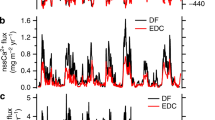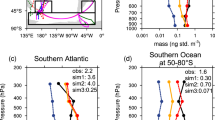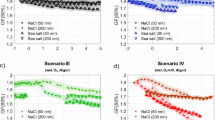Abstract
THE oxidation of sulphur dioxide to sulphate in the marine boundary layer (MBL) is an important pathway in the global sulphur cycle. Oxidation by ozone in the aqueous phase is an important process in cloud droplets1 but has not generally been thought to be significant in the clear air of the MBL. Yet the lower part of the MBL contains abundant sea-salt aerosol particles, which are largely water of sufficiently high pH (ref. 2) to support ozone oxidation of SO2 to sulphate. We have argued previously3 that 5–25% of the total non-sea-salt sulphate (n.s.s. SO2−4) observed in the MBL may be formed by this mechanism; here we assess its contribution to the cycling of sulphur in (and particularly its removal from) the MBL. We show that, owing to the effects of mass transfer, the n.s.s. SO2−4 so generated will be predominantly associated with particles of 2–9 μm diameter, and will accordingly dry-deposit at a rapid rate. Because part of the dimethyl sulphide (DMS) emitted by marine organisms is converted to SO2 in the MBL, this additional removal pathway for sulphur may markedly reduce the proposed feedback4 between greenhouse warming, oceanic DMS emissions and sulphate haze albedo.
This is a preview of subscription content, access via your institution
Access options
Subscribe to this journal
Receive 51 print issues and online access
$199.00 per year
only $3.90 per issue
Buy this article
- Purchase on Springer Link
- Instant access to full article PDF
Prices may be subject to local taxes which are calculated during checkout
Similar content being viewed by others
References
Seinfeld, J. H. Atmospheric Chemistry and Physics of Air Pollution (Wiley, New York 1986).
Winkler, P. in Chemistry of Multiphase Atmospheric Systems (ed. Jaeschke, W.) 269–298 (Springer, Heidelberg, 1986).
Sievering, H. et al. Atmos. Envir. A25, 1479–1487 (1991).
Charlson, R. J., Lovelock, J. E., Andreae, M. O. & Warren, S. G. Nature 326, 655–661 (1987).
Gravenhorst, G. Atmos. Envir. 12, 707–713 (1978).
Prospero, J. M. & Savoie, D. L. AEROCE Scientific Results from Phase I, 1988–90 (Rossenstiel School of Marine & Atmos. Sci., Univ. of Miami, 1991).
Sievering H., Ennis, G. & Gorman, E. Global biogeochem. Cycles 4, 395–405 (1990).
Pszenny, A. A. P., Artz, R. S., Boatman, J. F. & Galloway, J. N. Global biogeochem. Cycles 4, 121–132 (1990).
Kim, Y., Sievering, H. & Boatman, J. F. Global biogeochem. Cycles 4, 165–178 (1990).
Luria, M. and Sievering, H. Atmos. Envir. A25, 1489–1496 (1991).
Hoppel, W. A., Fitzgerald, J. W., Frick, G. M., Larson, R. E. & Mack, E. J. J. geophys. Res. 95, 3659–3686 (1990).
Sievering, H. et al. in Proc. 5th IPSASEP Conf. Richland, July, 1991 (eds Schwartz, S. & Slinn, W. G. N.) (in the press).
Schwartz, S. in Chemistry of Multiphase Atmospheric Systems (ed. Jaeschke, W.) 415–471 (Springer, Heidelberg, 1986).
Sahni, D. J. nucl. Energy 20, 915–920 (1966).
Luria, M. et al. Global biogeochem. Cycles 4, 381–394 (1990).
Ray, J. D., Van Valin, C. C. Luria, M. & Boatman, J. F. Global biogeochem. Cycles 4, 201–214 (1990).
Fitzgerald, J. W. Appl. Optics 28, 3534–3538 (1989).
Hänel, F. Adv. Geophys. 19, 73–188 (1976).
Gorman, E. Mass Transfer Limitation of S(IV) and Ozone in Coarse-Mode Aerosol Particles (Center for Environ. Sciences, Univ. of Colorado, 1992).
Slinn, W. G. N. in Precip. Scav., Dry Deposition, and Resusp., Vol. 2 (eds Pruppacher, H. R., Semonin, R. G. & Slinn, W. G. N.) 1361–1416 (Elsevier, New York 1983).
Chameides W. L. & Stetson, A. W. J. geophys. Res. (in the press).
Kopcewicz, B. et al. Atmos. Res. 26, 245–271 (1991).
Andreae, M. O. et al. Science 232, 1620–1623 (1986).
Sievering, H. J. geophys. Res. 89, 9679–9681 (1984).
Slinn, S. A. & Slinn, W. G. N. Atmos. Envir. 14, 1013–1016 (1980).
Luria, M. et al. Atmos. Envir. 23, 139–147 (1989).
Leck, G. & Rodhe, H. J. atmos. Chem. 12, 63–86 (1991).
Blanchard, D. & Woodcock, A. H. N. Y. Acad. Sci. 338, 330–347 (1980).
Zhuang, G., Yi, Z., Duce, R. A. & Brown, P. Nature 355, 537–539 (1992).
Author information
Authors and Affiliations
Rights and permissions
About this article
Cite this article
Sievering, H., Boatman, J., Gorman, E. et al. Removal of sulphur from the marine boundary layer by ozone oxidation in sea-salt aerosols. Nature 360, 571–573 (1992). https://doi.org/10.1038/360571a0
Received:
Accepted:
Issue Date:
DOI: https://doi.org/10.1038/360571a0
This article is cited by
-
Global high-resolution emissions of soil NOx, sea salt aerosols, and biogenic volatile organic compounds
Scientific Data (2020)
-
Substantial Seasonal Contribution of Observed Biogenic Sulfate Particles to Cloud Condensation Nuclei
Scientific Reports (2018)
-
Heterogeneous Reaction of SO2 on Manganese Oxides: the Effect of Crystal Structure and Relative Humidity
Scientific Reports (2017)
-
Mineral dust and NOx promote the conversion of SO2 to sulfate in heavy pollution days
Scientific Reports (2014)
-
Sulfur dioxide in the tropical marine boundary layer: dry deposition and heterogeneous oxidation observed during the Pacific Atmospheric Sulfur Experiment
Journal of Atmospheric Chemistry (2009)
Comments
By submitting a comment you agree to abide by our Terms and Community Guidelines. If you find something abusive or that does not comply with our terms or guidelines please flag it as inappropriate.



